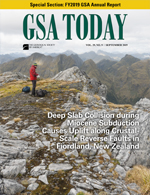Abstract View
Volume 29 Issue 9 (September 2019)
GSA Today
Article, pp. 4-10 | Full Text | PDF (3.3MB)
Deep Slab Collision during Miocene Subduction Causes Uplift along Crustal-Scale Reverse Faults in Fiordland, New Zealand
Cover Image
Search Google Scholar for
- Keith Klepeis
- Laura Webb
- Hannah Blatchford
- Joshua Schwartz
- Richard Jongens
- Rose Turnbull
- Harold Stowell
Search GSA Today
-------
* Now at the Dept. of Earth Sciences, University of Minnesota,116 Church Street, Minneapolis, Minnesota 55455, USA.
Abstract
A new multidisciplinary project in southwest New Zealand that combines geological and geophysical data shows how and why deep lithospheric dis‐placements were transferred vertically through the upper plate of an incipient ocean-continent subduction zone. A key discovery includes two zones of steep, downward-curving reverse faults that uplifted and imbricated large slices of Cretaceous lower, middle, and upper crust in the Late Miocene. Geochemical and structural analyses combined with 40Ar/39Ar geochronology and published images from seismic tomography suggest that the reverse faults formed at 8–7 Ma as a consequence of a deep (~100 km) collision between subducting oceanic lithosphere and previously subducted material. This collision localized shortening and reactivated two crustal-scale shear zones from the upper mantle to Earth’s surface. The event, which is summarized in a new lithospheric-scale profile, is helping us answer some long-standing questions about the origin of Fiordland’s unique lower-crustal exposures and what they tell us about how inherited structures can transfer motion vertically through the lithosphere as subduction initiates.
Manuscript received 13 Dec. 2018. Revised manuscript received 15 Mar. 2019. Manuscript accepted 20 Mar. 2019. Posted 26 Apr. 2019.
© The Geological Society of America, 2019. CC-BY-NC.

